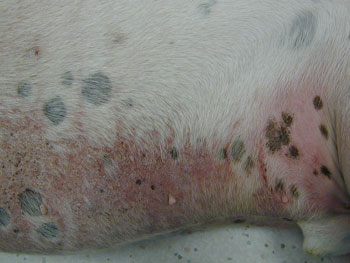Summer Watch: Skunk!
It’s a distinct odor recognized by nearly everyone and when your pet gets sprayed by a skunk, there is no mistaking the smell! Skunks are found across North America and have been quite adaptive to urban areas, so any pet that has access to an outside area has the potential of meeting this black and white stink machine. Summer is a particularly active time for skunks and with babies usually born in the spring, it becomes a family affair.Although they are omnivores, skunks are fond of pet food and leaving it out is an invitation for an outdoor buffet line. Skunks will enter open garages where many cats often have their food and housing creating a showdown with only one winner.
Fortunately, the spray is not fatal, although it smells like it. If your pet gets sprayed, forget the often- mentioned method of a bath in tomato juice and instead try this tested recipe. Mix together:
¼ cup baking soda
2 teaspoons Dawn ® dish soap
2 pints hydrogen peroxide
Put on your pet-washing clothes and wear rubber gloves. Shampoo the solution into the hair, creating a lather. Rinse. Repeat. Avoid getting the solution in the eyes and mouth. Towel dry. A second application may be required.
ADC Doctor to Lead Derm College
Dr. Rusty Muse of Animal Dermatology Clinic – Tustin has been named President of the American College of Veterinary Dermatology (ACVD).The ACVD is the governing body responsible for the guidance and oversight of the membership of boarded veterinary dermatologists in the United States. The ACVD also administers the annual board examination, organizes the annual meeting and addresses concerns impacting veterinary dermatology.
Dr. Muse has been very active and held numerous positions in ACVD and has been on the Executive Board for the previous six years and is the current Secretary of the College. In addition, he was the Publicity Committee Chair of the recently held World Congress of Veterinary Dermatology meeting held in Vancouver, British Columbia. That event drew 1,800 dermatologists and veterinarians from around the world.
His position as President will run for two years. “I am excited and honored to have been elected to this position with the ability to serve the College and to help guide and influence the specialty of dermatology,” says Dr. Muse.
He is the third member of Animal Dermatology Clinic to hold this prestigious position. Drs. Craig Griffin and Wayne Rosenkrantz have also been past presidents of the College.
The doctors and staff at Animal Dermatology Clinic are equally excited for Dr. Muse as he embarks on his new leadership role at the ACVD.

 The term “solar dermatitis” refers to the damaging effects of the sun on the skin of cats and dogs. The effects of ultraviolet light on the skin of pets are usually cumulative and may not be seen until after prolonged sun exposure, often years! Although animals can experience sunburn, which causes a reddening of the skin similar to what is seen in humans, we more commonly see the more chronic effects of long-term sun exposure.
The term “solar dermatitis” refers to the damaging effects of the sun on the skin of cats and dogs. The effects of ultraviolet light on the skin of pets are usually cumulative and may not be seen until after prolonged sun exposure, often years! Although animals can experience sunburn, which causes a reddening of the skin similar to what is seen in humans, we more commonly see the more chronic effects of long-term sun exposure. The bright green grasses of spring begin to dry and turn amber during these long days of summer. Although we rarely think about dried grass causing problems, one grass in particular can be troublesome to pets, the foxtail. There are many types of foxtails, but species Hordeum also known as “wild barley” is a frequent culprit of summer.
The bright green grasses of spring begin to dry and turn amber during these long days of summer. Although we rarely think about dried grass causing problems, one grass in particular can be troublesome to pets, the foxtail. There are many types of foxtails, but species Hordeum also known as “wild barley” is a frequent culprit of summer.